Experimental Research on the Anti-Anaerobic and Anti-Fungal
作者:Rong Xiang Xu 出版社:KARGER 发行日期:In 2004INTRODUCTION
Clinical research data of BRT with MEBT/MEBO revealed that MEBO has a strong ability to retard wound infection. Its mechanism is myriad(1). This paper reports the effect of MEBO on the morphological structure, colony character and pathogenicity of anaerobic spore bearing bacillus (Bacillus tetani), anaerobic non-spore-bearing bacillus (Bacteroides fragilis, Propionibacterium acnes) and fungi (Candida albicans). MEBO has been proven to possess strong broad-spectrum antibacterial effects. MEBO also creates an environment for preserving the residual surviving cells in the burns area and to promote their proliferation(2). Thus, MEBO offers a dual regulatory effect.
MATERIALS AND METHOD
Materials
Aquarium Type B224 was designed by the laboratory of the Affiliated Hospital of Binzhou Medical College. Culture medium was supplied from Shanghai Biological Preparation Institute. Bacteroids fragilis and propionibacterium acnes were purchased from Shanghai Medical University; Bacillus tetani and Candida albicans from the laboratory of the Affiliated Hospital of Binzhou Medical College. These bacteria were cultured respectively in anaerobic agar medium for use.
Method
MEBO group. The above-stated four species of bacteria were inoculated respectively into the medium containing a certain amount of MEBO. Anaerobic bacteria were incubated at 37oC for 48 - 72 h as one generation. Candida albicans was incubated at 37oC for 24 - 48 h as one generation. After 4 - 6 successive generations, they were treated with Gram stain and their staining reaction, morphology and colony characters were observed.
Control group: The above-stated original bacteria were observed before being inoculated into the medium containing MEBO.
Examination Indexes
Variation of the Bacteria.
1. Bacteroids fragilis, Propionibacterium acnes and Bacillus tetani were inoculated respectively into the medium containing MEBO and cultured for multiple generations during which morphological and colony variations at each generation were observed.
2.Variations of Candada albicans were observed after cultured in MEBO-containing media.
Spore Tube Test.
Original Candida albicans and the 1st, 2nd, 5th and 6th generations after being cultured in MEBO-containing media were inoculated into 0.5 ml human serum medium and cultured at 37oC for 3 h, the fungi were smeared, stained and 500 counts of the fungi were observed to determine the spore tube producing rates.
Effect of MEBO on Bacterial Growth.
Equal amounts of the colonies of the 10th generation of Staphylococcus aureus, and Bacillus pyocyaneus cultured in MEBO-containing media and the original bacteria of the two species were ground and placed into 0.1 ml of saline, respectively, then 1 ml of saline was added and the counts of the bacteria were compared.
Effect of MEBO on the Invasive Power of B. pyocyaneus.
The 10th generation of B. pyocyaneus cultured in MEBO-containing media and the original B. pyocyaneus cultured in ordinary media were taken and diluted separatelyly to 3 x 106/ml. 0.1 ml of the bacteria solutions were injected into mice intracutaneously. After 20 h the mice were killed. A block of rectangular skin tissue to the muscular layer was taken from the injection site of each mouse. The tissue blocks were made into sections and stained with HE stain and observed.
RESULTS
1). The effect of MEBO on anaerobic bacteria is given in Table 51 and depicted in Figures 17-19. The effect of MEBO on Candia albicans is given in Table 52 and depicted in Figure 20. The effect of MEBO on the proliferation rates of Staphylococcus aureus and Pseudomonas aeruginosa is given in Table 53. The effect of MEBO on the invasiveness of Pseudomonas aeruginosa is shown in Table 54.
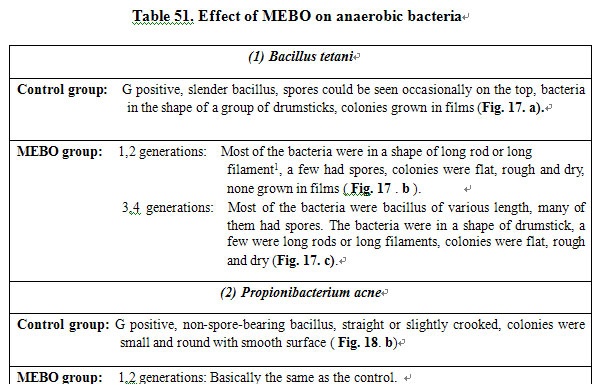
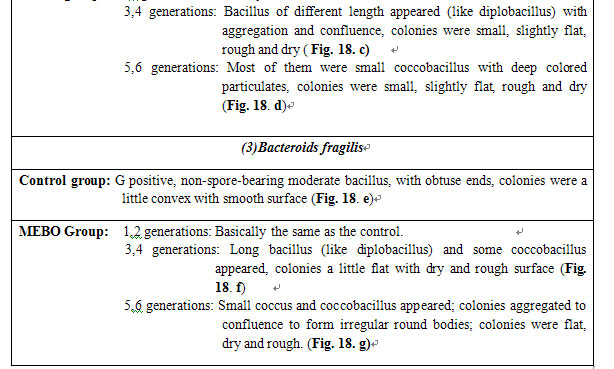
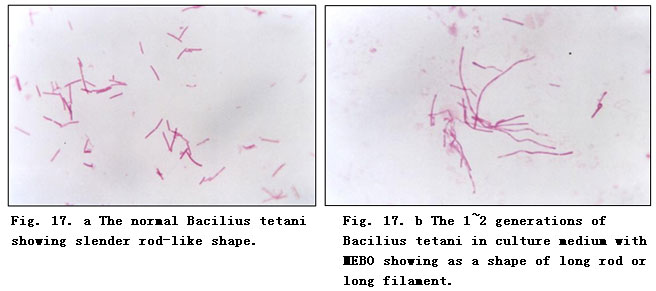
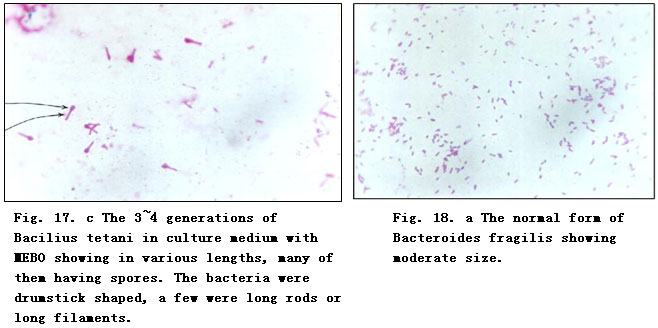
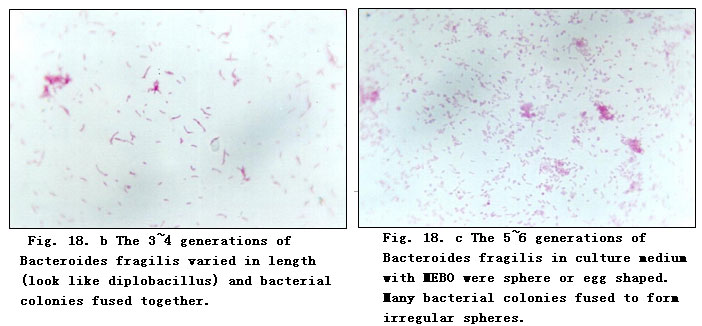
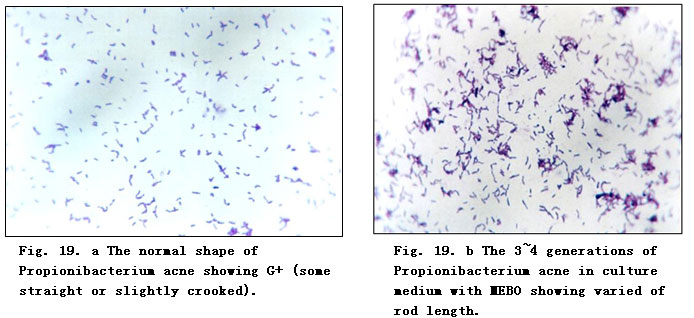
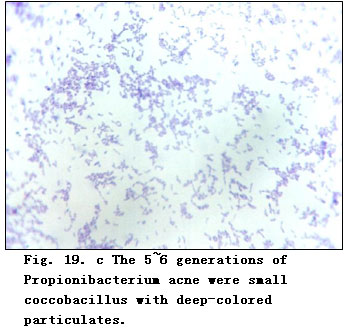
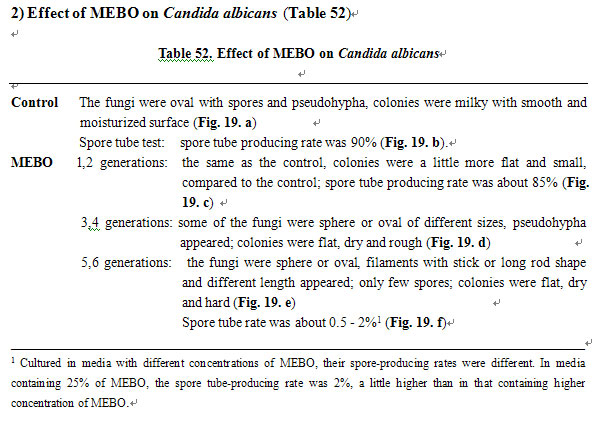
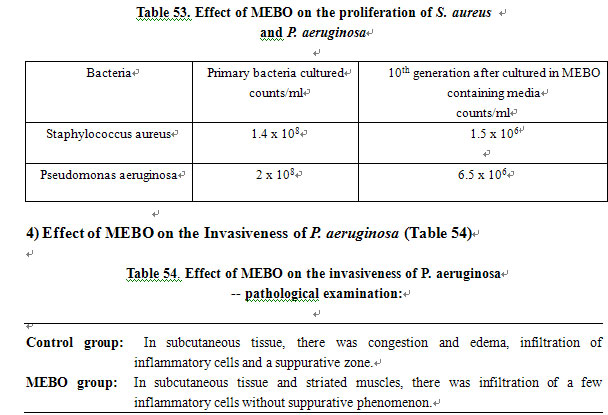
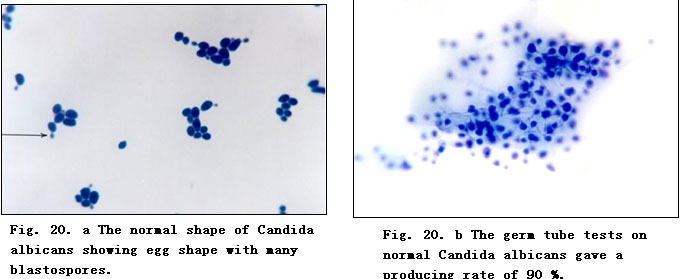
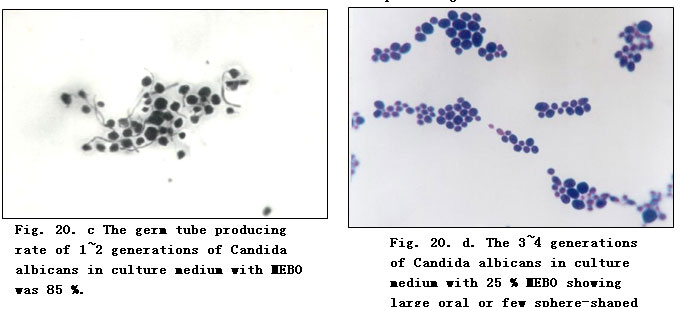
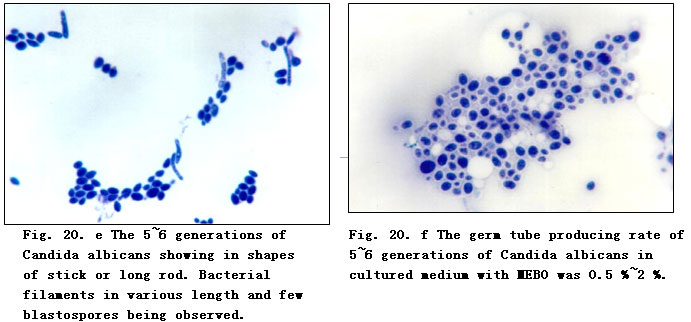
DISCUSSION
Micro-organisms proliferate rapidly and are accordingly susceptible to unfavorable factors in their growing environment. These changes in their environment may result in variations of their characteristics including morphological structure, culture feature, toxicity, antigenicity and drug resistance, etc. Morphological structure variations are directly related to cell division. Cell division is a complicated process and is more susceptible to unfavorable factors in the environment than to protein and DNA syntheses. For example, Bacillus tetani and Bactorids fragilis may have polymorphic variations such as polynuclear filaments or spheres because, in an unfavorable environment, cell membrane synthesis is delayed and cell division cannot proceed in a timely manner, while metabolism proceeds normally. Variation is closely related to the effect of the strength and the duration of action of the unfavorable factors. In our experiment, we found that the same bacteria demonstrated variation in morphological features when cultured in media containing different concentrations of MEBO (data not shown).
In this experiment, we observed the antibacterial effect of MEBO on Bacillus tetani, Propionibacterium acnes and Candida albicans. These micro-organisms are normal flora and opportunistic pathogens in the human body. Under certain conditions they become pathogenic and, in most clinical cases, the infections are endogenous in etiology. Burns patients often receive large doses of antibiotics, which always create an imbalance in native flora thereby facilitating the overgrowth of opportunistic pathogens such as Candida albicans. Aerobic bacteria infections such as Staphylococcus aureus, E. coli and B. pyogeneus predominant in burns wounds though anaerobic bacteria infections may also occur since burns wounds may become ischemic and necrotic. Therefore, bacterial examination of wounds should always consider both aerobic and anaerobic bacteria. In 1983, Wang Dewang reported a positive anaerobic bacteria detected rate of 23.9% in 34 cases of burns and most of them had mixed infections.
Bacillus tetani is an anaerobic spore-bearing bacteria. After being cultured in MEBO-containing media, long filament variants appeared, and in 3 generations many of them formed only one spore. This spore is not the vegetative form of the bacteria as it cannot proliferate under normal conditions. Spore keeps the bacteria alive though dormant. Only under favorable conditions can the spore proliferate and produce exotoxin to cause disease. After cultured in MEBO-containing media for 6 generations, in Candida albicans the number of blastospores was significantly reduced, the spore tube producing rate was only 0.5% - 2%, while the normal fungi had a spore tube producing rate of 90%. The above facts prove that MEBO has an inhibitory effect on the proliferation and pathogenicity of Bacillus tetani and Candida albicans.
From Table 53, we can see the effect on Bacillus pyocyaneus. After this bacerian was cultured in MEBO-containing media for 10 generations, we again cultured the 10th generation for another 20 h and discovered that the bacteria count/ml was greatly reduced to only 1/30 of that of the original. The invasiveness of this organism to mice was also greatly decreased. This proved that under an unfavorable environment, not only morphological structures but also physiological features of the bacteria are subject to variations.
Our data as well as many experimental and clinical data reported by other workers proved that MEBO has a broad-spectrum antibacterial effect and can also promote wound healing. Therefore, MEBO is a drug with a dual regulatory effect.
REFERENCE
1. Yang K, Ma J, Yang Q, et al: A comprehensive report on the therapeutic effect of MEBO in treating 4954 cases of various wounds and ulcers. Chin J Burns Wounds Surface Ulcers 1997; 4 : 15-21
2. Xu Rongxiang. China Burns and Wounds Medicine. Burns Wounds Surface Ulcers 1997; pp137 – 140.









